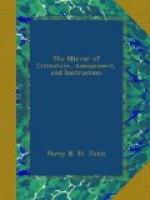The life-time of Ariosto was shortened by the intensity with which he applied himself to the production of his works. One of his last labours was a corrected and enlarged edition of his splendid Orlando Furioso. The printing was, however, so badly executed, as to cause him to say “he had been assassinated by his printer.” Mr. Stebbing observes, “it is probable that this circumstance, combined with the fatigue attending his close application while preparing the edition for the press, had a serious effect on his health, which now began to exhibit signs of rapid decline."[3] In the spring of 1533 he was seriously attacked with indigestion. The constant application of medicine to remove this complaint brought on a consumption, and on the night of June 6, in the same year, he breathed his last, “his death, it is worthy of mention, having been preceded only a few hours by the total destruction of Alphonso’s splendid theatre by fire;” which theatre, it should be added, the poet had designed for his noble patron a few years before: “so superb and convenient was the structure, when finished, that it was the admiration of all Italy.”
“Ferrara, all Italy, and even Europe, lamented Ariosto as the first poet of the age, and as worthy of being enrolled in the same chart of fame with the greatest that had ever lived. His funeral was rendered remarkable by the attendance of a large body of monks, who to honour his memory, followed him, contrary to the rules of their order, to the grave. His son, Virginio, shortly after built a small chapel in his garden, and formed a mausoleum to which he intended to remove his remains, but the same monks prohibited it, and the body was left in the humble tomb in which it was originally deposited, till the new church of S. Benedetto was built, when Agostino Mosti, a gentleman of Ferrara, raised above it a monument more worthy of the poet. In 1612 his great grandson, Ludovico, erected a still nobler one, and removed the ashes of his ancestor from the tomb of Agostino, as the latter had done from the one in which they were originally deposited. This monument of Ludovico, which still exists, is built of the most costly marble, and adorned with two statues representing Glory and Poetry, together with an effigy of the poet in alabaster.”
Lord Byron illustrates a singular circumstance respecting the tomb of Ariosto. “Before the remains were removed from the Benedictine Church to the Library of Ferrara, his bust, which surmounted the tomb, was struck by lightning, and a crown of iron laurels melted away:—
“’The lightning
rent from Ariosto’s bust
The iron crown of laurels’
mimic’d leaves;
Nor was the ominous element
unjust,
For the true laurel-wreath
which glory weaves
Is of the tree no bolt of
thunder cleaves,
And the false semblance but
disgraced his brow;
Yet still, if fondly Superstition
grieves,
Know, that the lightning sanctifies
below
Whate’er it strikes;—yon
head is doubly sacred now.’"[4]




